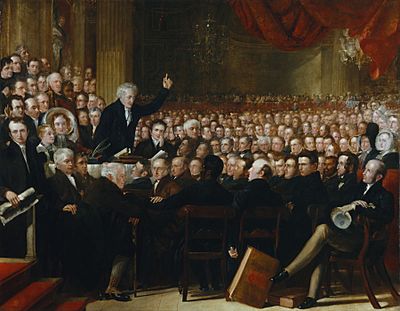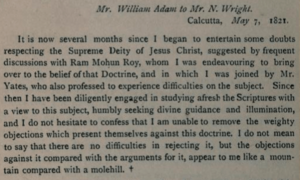William Adam (minister) facts for kids
William Adam (born November 1, 1796 – died February 19, 1881) was a British minister and missionary. He was also a strong supporter of ending slavery, known as an abolitionist. Later in his life, he became a professor at Harvard University.
Contents
Early Life and Work in India
William Adam was born in Dunfermline, Scotland. He was inspired by a church leader named Thomas Chalmers to become a missionary. Adam studied at the Baptist College in Bristol and the University of Glasgow.
Becoming a Missionary
By 1818, Adam was working as a missionary in India, north of Calcutta. He worked hard to learn two important languages: Sanskrit and Bengali. After learning these, he helped translate the New Testament into Bengali. He worked with Ram Mohan Roy, who was a very influential Indian thinker.
New Ideas and Changes
After many discussions about Christianity and Indian beliefs, Adam began to have doubts about some Christian teachings. He then left the Baptist Mission. However, he still wanted to stay in India. With Ram Mohan Roy and others, he helped create the Calcutta Unitarian Society. This group later changed as its Hindu members became interested in new ideas from the Brahmo Somaj movement.
In 1830, the government in Bengal asked Adam to study and report on the education system for local people.
Fighting Slavery in America and Britain
With help from friends in America, William Adam sent his family there. He followed them a few years later in 1838. In America, he met many people who wanted to end slavery, called abolitionists.
Speaking Out Against Slavery
Because of his background, American abolitionists chose him to represent them. He went to an anti-slavery meeting in London organized by the British India Society.
Merchants in Boston were very impressed by Adam's language skills. They helped him become a Professor of Oriental Linguistics at Harvard University. However, by 1840, he was writing public letters to Thomas Fowell Buxton. He warned that Britain should not think slavery was gone just because it ended in the West Indies. He pointed out that slavery still existed in India.
The World's Anti-Slavery Convention
In 1840, Adam traveled with many other Americans to the World's Anti-Slavery Convention in London. There, he gave a speech about the situation in India. After the convention, a famous painting was made to show the important people who attended. This painting is now in the National Portrait Gallery, London. William Adam can be seen in the very top right corner.
Adam arrived late to the convention because of a shipping delay. He came with other important figures like William Lloyd Garrison. They learned that the women delegates were not allowed to join the main discussions. Many clergymen, not from the Church of England, had voted against them. To protest this decision, Adam and three other men chose to sit with the women delegates. Adam famously said, "If women had no right there, he had none." He meant that his right to be there came from the same people and group as the women's.
New Paths and Challenges
Adam later resigned from his professorship at Harvard. He wanted to stay in London for over a year. During this time, he edited a newspaper called the British Indian Advocate for the British India Society. After this, he decided to join and invest in an experimental community in Massachusetts called the Northampton Association of Education and Industry.
By 1843, he was reporting on the British anti-slavery movement to Americans. He also worked as the secretary for the British India Society. He eventually lost his investment in the Northampton community. In the winter of 1844, he began teaching women in Boston.
Later Ministry in North America
William Adam returned to his work as a minister. Following advice from Samuel Joseph May and the American Unitarian Association, he became the first Unitarian minister in Toronto in 1845. He had some success there, but the next year he moved to become a minister at the First Unitarian Church of Chicago. This was also a short-term role. His next recorded Unitarian sermon was in Essex in 1855.
He has been called the "first international Unitarian of modern times." However, by 1861, he had stopped being a Unitarian.
Final Years in England
William Adam passed away in Beaconsfield, England, in 1881. At his own request, he was buried in a grave without a headstone. He left his money to create scholarships for students at the local grammar school. These scholarships were specifically meant to be given without any unfairness or prejudice.
Images for kids






